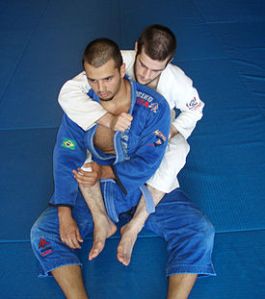Wonderful World of Leg and Foot locks
In Brazilian jiu-jitsu there are a number of submissions that involve putting pressure on points in the legs to cause a tap out. Completely unsurprisingly there are categorized as leg locks. They can be extremely useful in BJJ because they can be easy to use but also hard to defend against without good technique. In mixed martial arts they are seen less often but can still be extremely useful because its only natural for an opponent to protect his head and arms in a fight while leaving legs out in the open for attack.
It is much more natural for people to work with their arms than their legs. Our hands can hold onto things to help anchor them into position and generally have better fine movement control; both things are good for defending against submission attacks. However an opponent certainly wont be clasping his feet together to prevent a knee bar, unless of course he is half chimp. Also in mixed martial arts just going for any type of leg lock generally takes you out of effective striking range which is a plus.
The last advantage of a leg lock, especially in a MMA arena, is the element of surprise. Its natural to defend against attacks to the upper body more than the lower. If your still not convinced watch the great Anderson Silva get caught hook line and sinker in a leg lock when he could have easily won the fight
Achilles Foot Lock
There are a few basic leg or foot locks taught in brazilian jiu-jitsu, with each having multiple variations of course. The most basic of which is probably the Achilles foot lock. This basic submission consists essentially of putting the opponent’s foot in a guillotine choke; his Achilles tendon being the neck and the pressure being placed on the tendons/ligaments in the top of the foot. Your whole body is used to push back on the foot causing pain and the risk of tearing needed tendons. This foot lock is effective because of its simplicity and flexibility.
Heel Hook
Another type of leg lock is called a heel hook. These are quick and deadly submissions that put enormous pressure on the knee and demand a quick tap out when sunk in correctly. In training there is great care to finish this move in because of the possibility of damage to the knee from the applied pressure.
The basic idea behind the submission is to immobilize the opponents foot and lower leg against your body and upper leg with your legs. The two are then rotated independently with the two halves of your body to put pressure on the opponents knee. It doesn’t even sound all that simple but it is still easier said than done. There are also a number of variations to the heel hook which make it a serious threat in the hands of an expert.
UFC fighter Rousimar Palhares is known for his leg locks and more specifically his heel hook. For some of his highlights and technical breakdown of a more complex heel hook setup CLICK HERE.
Less Common Locks
The knee bar is another leg lock that is taught in Brazilian jiu jitsu. As the name would imply this is essentially an arm bar for the knee. The pressure put on the knee to bend it in the opposite direction generates excruciating pain and can cause injury if the victim does not tap out. This is a less common submission because of a generally lower success rate than other leg locks.
Lastly there is a calf crank. The calf crank is not a traditional submission that aims to rip apart a joint. Instead it focuses on putting pressure on the opponents calf muscles and lower leg bones. This means that it causes more pain than threat of injury. The calf crank isn’t seen much or a guaranteed submission but there are a ton of variations that make its use very flexible. For an in depth look at the calf crank CLICK HERE.








